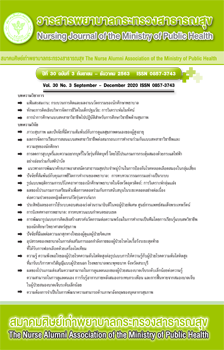The Effectiveness of Utilization of the Ramathibodi Rapid Response System in Premium Wards at Somdech Phra Debaratana Medical Center
Main Article Content
Abstract
This retrospective research study was conducted to investigate the severity of the patients differentiated by their personal background and compare the number of patients transferred to the intensive care unit (ICU), cardiac arrest and in-hospital mortality before and after using the Ramathibodi Rapid Response System (RRRS). The sample consisted of adult patients aged over 15 years who were admitted to the premium ward at Somdech Phra Debaratana Medical Center Past patient medical records were studied as a review. The study included 6,730 patients in the pre-RRRS group and 6,948 in the post-RRRS group. The instruments used consisted of the hospital protocol for response to the deterioration of patients; a tool of Ramathibodi early warning score; demographic information; the Ramathibodi early warning score record form. Data were analyzed using descriptive and t-test statistics. The results revealed that: 1) the severity level of patients who come to receive services divided by risk level, with an average score of .39 ± 1.198 points, and a score that ranged between (min-max) 0-18 points. 2) The number of patients transferred to ICU decreased significantly at the .05 level after using the RRRS. There were no significant differences in cardiac arrest and in-hospital mortality between the two groups.
Article Details
บทความและรายงานวิจัยในวารสารพยาบาลกระทรวงสาธารณสุข เป็นความคิดเห็นของ ผู้เขียน มิใช่ของคณะผู้จัดทำ และมิใช่ความรับผิดชอบของสมาคมศิษย์เก่าพยาบาลกระทรวงสาธารณสุข ซึ่งสามารถนำไปอ้างอิงได้
References
2. Ludikhuize J, Brunsveld-Reinders AH, Dijkgraaf MG, Smorenburg SM, de Rooij SE, Adams R. et al. Outcomes associated with the nationwide introduction of rapid response systems in the Netherlands. Crit Care Med.2015;43(12):2544-51.
3. Salvatierra GG, Bindler RC, Daratha KB. Rapid response teams: Is it time to reframe the questions of rapid response team measurement? J Nurs Scholarsh.2016;48(6):616-23.
4. McNeill G., Bryden D. Do either early warning systems or emergency response teams improve hospital patient survival?: a systematic review. Resuscitation.2013;84(12):1652-67.
5. Alam N, Hobbelink EL, van Tienhoven AJ, van de Ven PM, Jansma EP, Nanayakkara PW. The impact of the use of the Early Warning Score (EWS) on patient outcomes: a systematic review. Resuscitation. 2014;85(5):587-94.
6. Tirkkonen J, Tamminen T, Skrifvars MB. Outcome of adult patients attended by rapid response teams: a systematic review of the literature. Resuscitation.2017;112:43-52.
7. Smith ME, Chiovaro JC, O’Neil M, Kansagara D, Quiñones AR, Freeman M et al. Early warning system scores for clinical deterioration in hospitalized patients: a systematic review. Ann Am Thorac Soc. 2014;11(9):1454-65.
8. Solomon RS, Corwin GS, Barclay DC, Quddusi SF, Dannenberg MD. Effectiveness of rapid response teams on rates of in-hospital cardiopulmonary arrest and mortality: a systematic review and meta-analysis. J Hosp Med.2016;11(6):438-45.
9. Maharaj R, Raffaele I, Wendon J. Rapid response systems: a systematic review and meta-analysis. Crit Care.2015;19(1):254.
10. Patel MS, Jones MA, Jiggins M, Williams SC. Does the use of a track and trigger warning system reduce mortality in trauma patients?. Injury.2011;42:1455–9.
11. Peris A, Zagli G, Maccarrone N, et al. The use of Modified Early Warning Score may help anesthesists in postoperative level of care selection in emergency abdominal surgery. Minerva Anestesiol. 2012;78:1034–8.
12. The Healthcare Accreditation Institute. Hospital and healthcare standard. 4th eds. Bangkok: One D books; 2019. (in Thai).
13. Paterson R, MacLeod DC, Thetford D, Beattie A, Graham C, Lam S, Bell D. Prediction of in-hospital mortality and length of stay using an early warning scoring system: Clinical audit. Clin Med (Lond). 2006;6(3):281–4.
14. Segon A, Ahmad S, Segon Y, Kumar V, Friedman H, Ali M. Effect of a rapid response team on patient outcomes in a community-based teaching hospital. J Grand Med Educ.2014;6(1): 61-4.
15. Donabedian A. An introduction to quality assurance in health care. New York: Oxford University Press; 2003.
16. Meyers CV, Brandt WC. Implementation fidelity in education research: Designer and evaluator considerations. New York, NY: Routledge;2015.
17. Burns N, Grove SK, Gray J. Understanding nursing research: Building an evidence-based practice. 6th eds. St. Louis, Missouri: Elsevier, 2015.
18. Melnyk BM, Fineout-Overhot E. Evidence-Based Practice in Nursing & Healthcare: A Guide to Best Practice. 4td eds. North American: Wolters Kluwer Health;2018.
19. Howell DC. Statistical methods for psychology. 8th ed. Belmont, California: Wadsworth Cengage Learning;2013.

